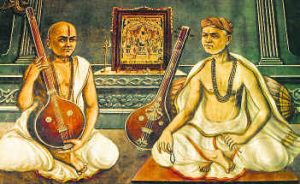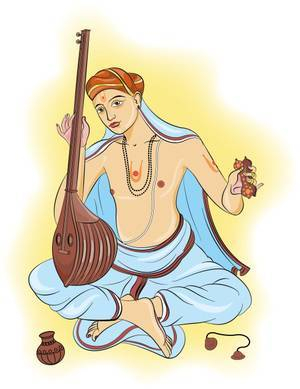It is customary for TLM, The Lost Melodies to talk about the lost compositions. For a change, we come up with the last compositions of Svamigal on his Aradhana day.
Sri Tyagaraja was born in the year 1767, May 4 in the holy town of Tiruvarur to Sri Ramabrahmam and Seethamma (Shanta) as a third son. Ramabrahmam, despite being a Sri Ramachandra Upasaka and a pious brahmana, unfortunately, begot two vile sons because of his karma. His mental agony was alleviated by a dream, wherein he envisioned Tyagesa of Tiruvarur and received a blessing from him saying he will be giving birth to a pious and noteworthy child soon. The words of Tyagesa wiped away his accumulated ‘duskarma’ and his wife gave birth to Tyagaraja.
The family moved to Tiruvayyaru and was led a much stable life. Sri Ramabrahmam, having initiated into Sri Rama Taraka Mantra from none other than Maruthanallur Svamigal, one of the triumvirate of Bhajana Sampradaya, wished to pass on the legacy. Tyagaraja was much blessed to have such a father and received ‘mantropadesha’ with great ingenuity. Whereas he inherited the valuable ‘life protector’ Sri Rama nama from his father, his mother bequeathed the knowledge of music and the philosophy of ‘parama bhagavatas’, namely Purandaradasar and Bhadrachalam Ramadasar. Later Tyagaraja continues to develop his knowledge by reading Vedas and holy scriptures. He was a much orthodox Brahmin performing his duties strictly is evident from many of his compositions.
Later he composed innumerable keertanas, had a vision of Narada Svami and Sri Ramachandra, and taught his compositions and philosophy to many disciples. His primary and one of the oldest disciple Valajapettai Sri Venkataramana Bhagavatar (the other being Tanjavur Rama Rao) and his son Sri Krishnasvamy Bhagavatar had recorded the biography of Tyagaraja Svamigal, even during his lifetime.

Tyagaraja himself has recorded many of the events that happened in his life through his compositions. They are available as internal evidence enabling us to understand the life of Tyagaraja. Few such kritis will be dealt with now. We do have 3 kritis wherein he ruminates his previous dialogue with Sri Ramachandra and two among these were composed in Paraabhava Markazhi (1846). The other one must have been composed even earlier and gives another valuable piece of information.
The kritis ‘giripai’ in Sahana and ‘paritapamu’ in Manohari (misattributed) conveys the same information. Both elaborate a dream Tyagaraja had, perhaps when he was in his fag end. It is interesting to note both these kritis mention Sri Rama promised Tyagaraja that he would get his grace in ten days. But the dream which made him compose ‘giripai’ is slightly anterior to the dream mentioned in ‘paritapamu’. In the kriti ‘paritapamu’ he not only recollects the promise but also questions with great anguish and disappointment of not keeping up the promise as ‘palukula marachitivo?’ (have you forgotten the words you uttered? It is generally believed that he was united with Sri Ramachandra after the mentioned ten days. We also have a few oral accounts saying he got initiated into Sanyasa as he was informed (by Sri Rama) that he will not get salvation in this birth and need to take more births to cleanse his karma. Since getting initiated into Sanyasa ashrama itself is a re-birth, Tyagaraja decided to enter the fourth stage and became Tyagaraja Svamigal (his deeksha name was Nadabrahmananda says few other accounts). Though the reliability of this story cannot be attested, it clearly fill in the gaps.
Herewith we provide a rendition of ‘paritapamu’ as notated in Valajapettai manuscripts. This will be much different from the concert versions and we made the following changes:
1. The refrain is stopped at ‘marachitivo’ and not at ‘paritapamu’ (commonly heard). The refrain stopping at this point makes more sense when joined with anupallavi and caranam. Also, the meaning of the pallavi looks more complete.
2. The pause between the various sections namely pallavi, anupallavi and caranam is much reduced to display the disappointment, anguish and urgency to get the grace, expressed in this kriti.
3. The sahitya is not repeated in parts, but as a the complete line to convey the meaning in an uninterrupted manner.
Whereas the concert forms might be appealing to the majority, these obsolete versions, when modified to suit the sahitya bhava, conveys the idea of the composer in a better form.
The third kriti is ‘daya juchutaku’ in the raga Ganavaridhi. In this kriti, the sahitya ‘mununivaanatichina’ is to be noted. It can be translated as ‘I have carried out the tasks which you commanded to be earlier’. But what was the task given to him? Few also consider ‘paramatmudu’ in Vagadisvari as one of his last creations. But this does not have internal evidence.
Certainly analysis of these keertanas reveals two points. First, his kritis are to be read and then collated with the authentic biographies. Second, there are many lacunae in understanding the incidents that happened in the life of Svamigal seamlessly. This mainly due to the paucity in the number of compositions, we inherited.
Having performed the duties at the behest of Sri Ramachandra, he gets united with his ishta devata. Venkataramana Bhagavatar used to celebrate his Aradhana only on Ekadashi, as he got a dream wherein Svamigal instructed him to do so and he used to observe bhajana on every Ekadashi.
Though singing panca ratna keertanas is now synonymous with Tyagaraja Aradhana, this author feels the kritis like ‘paritapamu, ‘giripai’ or ‘daya juchutaku’ can be included as a part of Aradhana. They not only remind the last days of Svamigal, but also his vision, interactions, and personal communications with his Sri Ramachandra in his own words.
Sri Tyagaraja Sahayam
Sri Tyagaraja Guru Padhukabhyam Namaha
Sri Tyagaraja Guru Parabrahmane Namaha
